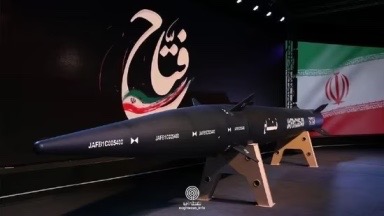Amid escalating tensions with the United States regarding Tehran’s nuclear program, Iran has asserted that its new missile, the Conqueror, possesses the capability to penetrate any regional missile defence system.

According to the Islamic Republic News Agency on Twitter, the missile known as “Conqueror” in Farsi has a maximum range of 1,400 kilometres (870 miles).
In an announcement on Tuesday, Iran claimed to have successfully developed a hypersonic missile named Fattah, which translates to “Conqueror” in Farsi. According to Iran’s state television, the missile boasts an extraordinary speed, capable of travelling at 15 times the speed of sound.
Furthermore, it is reported to possess a significant range, reaching up to 1,400 kilometres (870 miles). This development occurs against the backdrop of ongoing tensions between Iran and the United States, primarily centred around concerns surrounding Tehran’s nuclear program.
The Iranian state television report also asserted that the Fattah missile can surpass any regional missile defence system. However, no concrete evidence was presented to substantiate this claim.
As hypersonic technology presents a significant advancement in missile capabilities, Iran’s announcement raises questions and concerns, particularly regarding its potential impact on the geopolitical landscape and security dynamics in the region.
It is important to note that independent verification of Iran’s claims is essential to accurately assess the true capabilities of the Fattah missile. As international tensions persist, this development could further exacerbate the existing concerns surrounding Iran’s military capabilities and its impact on regional stability
During a TV broadcast, Iran’s Revolutionary Guard, a hard-line paramilitary organization in the country, unveiled what appeared to be a model of the newly developed hypersonic missile in the presence of President Ebrahim Raisi.
The Revolutionary Guard already possesses a significant stockpile of ballistic missiles. It is worth noting that back in November, General Amir Ali Hajizadeh of the Revolutionary Guard had previously claimed the creation of a hypersonic missile, but without providing any supporting evidence for the assertion.
The assertion regarding the development of hypersonic weapons emerged during a wave of nationwide protests that ensued following the tragic death of Mahsa Amini in Iran. Amini, a 22-year-old woman, passed away after her arrest by the country’s morality police in September. These protests brought attention to a significant issue: the potential challenges posed by hypersonic weapons.
Hypersonic weapons are distinguished by their extraordinary speeds, surpassing Mach 5, which is equivalent to five times the speed of sound. This remarkable velocity and the accompanying manoeuvrability make them extremely difficult to counter using existing missile defence systems. Consequently, the development and deployment of such weapons could potentially shift the balance of power in military conflicts.
Multiple nations are known to be actively engaged in the pursuit of hypersonic weapon technology. China and the United States have dedicated significant resources to their development, recognizing the strategic advantages they offer. Meanwhile, Russia claims to have already implemented these weapons, further stating that they have been utilized on the battlefield during the ongoing conflict in Ukraine.
The global interest and investment in hypersonic weapons highlight their potential impact on modern warfare. The ability to deliver high-speed, highly manoeuvrable strikes could disrupt traditional defence strategies, leaving nations reliant on outdated defence systems vulnerable to these advanced weapons.
It is important for countries to closely monitor the development and deployment of hypersonic weapons, as their introduction could have far-reaching implications for international security and stability. As the arms race in this domain continues, nations will need to reassess their defence capabilities and explore countermeasures to effectively respond to the emergence of hypersonic weapons.












